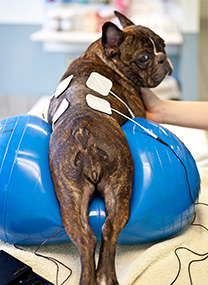Laurie's Blogs.
Jun 2018
E-stim & the Spinal Cord Injury

Photo Credit: http://www.paradisecaninerehab.com/about/hospital-tour/
Right off the bat, I will tell you that I had always thought that using e-stim on a spinal cord injured patient was garbage - A complete waste of time, and the client’s money! However, recently I came across a journal article that made me reconsider my ‘hard line’ thinking on this!
Early Cyclical Neuromuscular Electrical Stimulation Improves Strength and Trophism by Akt Pathway Signaling in Partially Paralyzed Biceps Muscle After Spinal Cord Injury in Rats
Gabriel R de Freitas, Caroline C do Espírito Santo, Nicolas A M M de Machado-Pereira, Franciane Bobinski, Adair R S dos Santos, Jocemar Ilha
Physical Therapy, Volume 98, Issue 3, 1 March 2018, Pages 172–181
The research used hemisectioned (C5 – C7 level) Wistar rats. They then used a 5-week (5 x per week) NMES protocol of ‘stimming’ the biceps brachii muscle, starting 48 hours after injury. The researchers then compared function, strength, muscle trophism, and expression of phosphorylated Akt and DSK-3ß (cellular anabolic pathway markers) in the ‘stimmed’ rats, the control rats (hemisectioned but no treatment), and a ‘sham’, control group. (The details of the NMES procedure weren’t shared on the abstract, so I can’t share those details… but I’m not sure that it would matter significantly, if they were using a common sense therapeutic protocol. They do say “cyclical”, so I assume they used an on time and an off time.)
Okay… so what they found:
•There was an increase in bicep muscle strength in the NMES group compared with the untreated SCI group, from postoperative day 21 until the end of the evaluation period.
•There was an increase in muscle trophism in the NMES group compared with the SCI group.
•Regarding muscle protein expression, the NMES group had higher values for phospho-Akt, phospho-p70S6K, and phospho-GSK-3ß than did the SCI group.
•However, forelimb function gradually recovered in both the SCI group and the NMES group, with no differences between them.
Alrighty! So, what do we think now? I’d say that if your patient is not functioning and / or you can work on retraining ‘function’ (i.e. Neuro Rehab), then a bit of electrical stimulation might make sense. Bear in mind that this research was on incomplete spinal cord injuries. As such, I’d think that if your dog is not showing signs of any improvement MONTHS into treatment… then the likelihood of NMES creating magical results is ‘slim to none’! The other thing that strikes me as well, is that the treated and untreated animals had no difference in function at the end of the study. And in my head, ‘FUNCTION’ is what it’s all about! Perhaps you get better function by practicing FUNCTIONAL TASKS.
So, here’s what I’m planning on doing based on this research. If I have a non-ambulatory patient with a spinal cord injury, I might add NMES to my treatment regimen. Maybe I’d rent one out to the owners to use daily at my instruction. Then as or if the animal starts to regain use and function, I would spend more of my time on the neuro rehabilitation principles, focusing on retraining functional tasks. I COULD still rent a unit out to owners to use at home… but I’m not going to spend 15 – 30 minutes of my ‘in clinic’ time using it there, when my skills are best used on therapies that require MY knowledge, deductive reasoning, evaluation, and hands.
There you go! I hope this helps spark your thinking!
Until next time…
Cheers! Laurie


